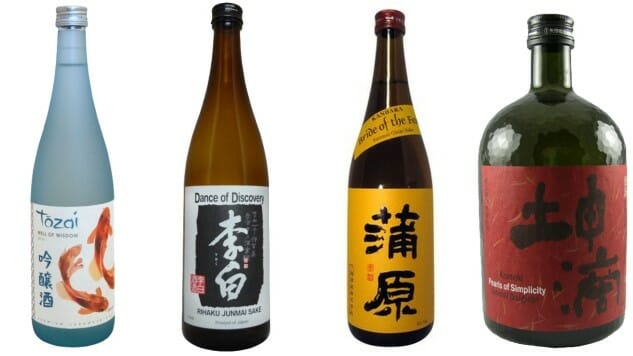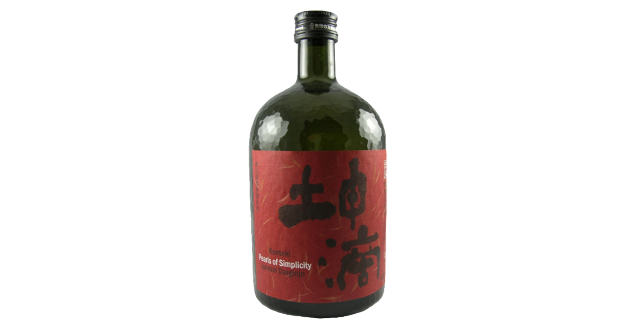
Sometimes we bump up against a libation category we haven’t learned to be discerning about for one reason or another. I have opinions about wine. I have opinions about beer. I have opinions on obscure, herb-driven spirits brewed by enclaves of monks in faraway mountains. But take me to a sushi bar and ask me what I want to drink and I get genuinely bemused. I know what it is, I know it’s complex, I know it’s one of the oldest, if not the oldest, spirits in the world (dating back to 4800 BCE according to some). And although I am aware that it is way more than the cheap stuff they serve hot at the place down the street, I’m also aware that I’m in over my head pretty fast looking at a menu. I actually like the cheap stuff they serve hot, especially on a cold day. But I get that there’s … quite a bit more going on, when it comes to sake.
Recently I had an opportunity to taste a dozen different sakes and learn a bit about them, and it made a pretty good dent in my baffled intimidation. So I’m reporting my findings for other sake novices (and nebbishes), because I know it’s not just me.
Sake means “liquor.” The more specific term for the national drink of Japan is Nihonshu. “Sake” will generally get you what you’re looking for in the US, though. Sake labels are at least as mystifying as wine labels. Here are a few basics for decrypting them:
Look at the ABV. With its mild flavors and petite serving sizes, sake can seem very innocuous, but it tends to pack significantly more of a punch than beer or wine (though less than clear spirits). 20% ABV is not uncommon. So bear in mind it’s a very quaffable libation that can sneak up on you-don’t drink it imagining it’s beer.
Sake is graded based on how “polished” the rice is, meaning how much of the exterior of the kernel has been milled away. Ginjo and Daiginjo are the designations for premium and super-premium grades, which are the most polished. A sake labeled Junmai is made strictly with rice, water, koji (a mold culture). Ginjo Junmai and Daiginjo Junmai indicate the same thing (high polish, no additives). Sake not labeled Junmai generally has a little added distilled alcohol, which enhances flavor and heightens the aromatics. Honjozo is a lightweight style with around 70% polishing ratio and some added alcohol. Nigori sake is cloudy white and can have residual rice floating in it. It tends to be sweet. That’s not a complete list of categories and subcategories, but it will get you started reading labels you’re likely to encounter in your local wine shop, and if none of those terms appear on the label you’re quite likely to be holding a bottle of … something perhaps better suited to cooking with, or using to light a fire.
I had to ask about the hot-or-cold thing. I was aware that most real sake connoisseurs sneer a bit at “hot sake,” and that it’s generally the mass-produced cheap stuff that gets served that way. But you know what, I like hot sake. Sorry: I do. That said, I don’t want to ruin something well-crafted by undue tampering, so if you’re like me: Ginjo and Daiginjo sakes should be lightly chilled. Junmai sake is the draft pick for heating if you are determined to do it.
Here’s the skinny on what was in my tasting flight.
Tozai “Snow Maiden” $10
Junmai Nigori: The notes from the producer say something like “bridges the gap between East and West” but I might beg to differ on that: based on my small focus group of sharers, at least, Nigori sake is a bit polarizing. Personally I’m not sure I like it; the idea appealed to me but the reality was I found the texture a little off-putting. It’s a little bit like what I imagined the pumpkin juice everyone drank in Harry Potter would be like-vegetal, a little viscous, and yes, it does have a slight pumpkin flavor. There’s also green melon and … well, the truth is it tastes like rice. Some people will love this. Not everyone.
Tozai “Well of Wisdom” $13
Ginjo: Approachable, for your palate and your pocketbook. This sake is soft, lush and juicy-a melon fest, with dominant notes of honeydew and ripe watermelon with a slightly nutty finish. Easy to pair with food, fine to drink on its own.

Rihaku “Dance of Discovery” $13
Junmai: Pretty strong salinity, in a good way. This sake is not super complicated-also in a good way. The flavor is brisk, slightly malty, with a trace of smoke and a dry, lingering finish. Easygoing and pleasant, but not without an edge. Super food-friendly.
Tozai “Typhoon” $14
Futsu: The sake equivalent of table wine. Very fresh-tasting and pleasant with notes of apple, lemon, toasted nuts and cream. Silky finish. A versatile, crowd-friendly sake that won’t ruffle the feathers of either novices or sake snobs-it’s solid and dependable.
Rihaku “Wandering Poet” $16
Junmai Ginjo: Vegetarians and salad lovers might want to watch out for this sake, which has the right kind of backbone to stand up to hard-to-pair assertive veggies like asparagus or kale. Light but grounded, it has pretty classic notes of honeydew, cantaloupe, and a trace of banana. The finish is herby, almost grassy.
Kanbara “Bride of the Fox” $17
Junmai Ginjo: Pretty intense aromatics favoring roasted almonds and pecans, and maybe macadamia because I had the briefest fleeting thought of a white chocolate macadamia cookie? The mid-palate is melon forward, and the finish is soft and sweet.
Konteki “Pearls of Simplicity” $20
Junmai Diaginjo: Clean and pure-tasting, a minimalist expression that’s as close to drinking brook water (or little fluffy clouds) as anything on this list. Pronouncedly floral nose with citrus blossom and jasmine drift into a pear and melon mid palate, with a slightly herbaceous finish. It’s elegant, perfumed, refined and classy.
Konteki “Tears of Dawn” $20
Daiginjo: This is the kind of sake that is, for me at least, dangerous: It’s got a tremendous stealth factor. Meaning you could put away a whole bottle and not feel a thing until you tried to stand up. It’s smooth as all getout and features subtle but rich notes of tropical fruit (banana and a bit of pineapple) over a forest floor kind of thing. Full-bodied, weighty, and suitable for drinking on its own, although like most sake it likes to be paired with a food friend. The producer’s suggestion is braised pork ribs, and that seems like a good starting point.
Yamada “Everlasting Roots” $32
Tokubetsu Junmai: Rich and delicious, this sake has a strongly savory character, but also sweet notes like cacao and baking spices, neroli and mandarin. It has a long, dry finish and sits firmly in the middle between “pair it” and “drink it alone.” It’s pleasantly complex but not confusingly so, and there’s just something inviting about it.
Kanbara “Ancient Treasure” $90
Yamahai Junmai Genshu Koshu: Possibly my favorite of this lineup, this sake is aged for more than ten years, giving it a deep golden color. The nose is about toffee. Toffee and caramel and pralines and everything candied, and also a little lemon. On the palate it’s a bit funky, with a strong umami character and notes of orange, smoke, pears and tea. It’s a long-finishing, gradually unfurling, very complex drink, and made for contemplation. I don’t think it’s a crowd pleaser, but the connoisseur in your life will love it.
